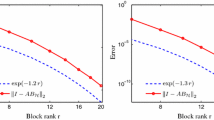Abstract
The inverse of the stiffness matrix of the time-harmonic Maxwell equation with perfectly conducting boundary conditions is approximated in the blockwise low-rank format of \({\mathcal{H}}\)-matrices. Under a technical assumption on the mesh, we prove that root exponential convergence in the block rank can be achieved, if the block structure conforms to a standard admissibility criterion.
Article PDF
Similar content being viewed by others
Avoid common mistakes on your manuscript.
Change history
14 November 2022
Missing Open Access funding information has been added in the Funding Note.
References
Angleitner, N., Faustmann, M., Melenk, J.M.: Approximating inverse FEM matrices on non-uniform meshes with \({\mathcal{H}}\)-matrices. Calcolo 58(3), Paper No. 31, 36 (2021)
Arnold, D.N., Falk, R.S., Winther, R.: Multigrid in H(div) and H(curl). Numer. Math. 85(2), 197–217 (2000)
Boffi, D., Brezzi, F., Fortin, M.: Mixed finite element methods and applications, Springer Series in Computational Mathematics, vol. 44. Springer, Heidelberg (2013)
Börm, S., Börst, C., Melenk, J.M.: An analysis of a butterfly algorithm. Comput. Math. Appl. 74(9), 2125–2143 (2017)
Bebendorf, M.: Why finite element discretizations can be factored by triangular hierarchical matrices. SIAM J. Numer. Anal. 45(4), 1472–1494 (2007)
Bebendorf, M., Hackbusch, W.: Existence of \({\mathcal{H}}\)-matrix approximants to the inverse FE-matrix of elliptic operators with \(L^{\infty }\)-coefficients. Numer. Math. 95(1), 1–28 (2003)
Bebendorf, M., Kuske, C., Venn, R.: Wideband nested cross approximation for Helmholtz problems. Numer. Math. 130(1), 1–34 (2015)
Börm, S., Melenk, J.M.: Approximation of the high-frequency Helmholtz kernel by nested directional interpolation: error analysis. Numer. Math. 137(1), 1–34 (2017)
Bebendorf, M., Ostrowski, J.: Parallel hierarchical matrix preconditioners for the curl-curl operator. J. Comput. Math., 624–641 (2009)
Börm, S.: Efficient numerical methods for non-local operators, EMS Tracts in Mathematics, vol. 14, European Mathematical Society (EMS), Zürich, , \({{\mathcal{H}}}^{2}\)-matrix compression, algorithms and analysis (2010)
Brenner, S.C., Scott, L.R.: The mathematical theory of finite element methods. Texts in Applied Mathematics, 3rd edn., vol. 15. Springer, New York (2008)
Costabel, M., McIntosh, A.: On Bogovskiĭ and regularized Poincaré integral operators for de Rham complexes on Lipschitz domains. Math. Z. 265 (2), 297–320 (2010)
de Bruijn, N.G.: Asymptotic methods in analysis. Bibliotheca Mathematica, 2nd edn., vol. 4. North-Holland Publishing Co., Amsterdam; P. Noordhoff Ltd., Groningen (1961)
Dölz, J., Harbrecht, H., Schwab, C.H.: Covariance regularity and \({\mathcal{H}}\)-matrix approximation for rough random fields. Numer. Math. 135 (4), 1045–1071 (2017)
NIST Digital Library of Mathematical Functions, http://dlmf.nist.gov/, Release 1.1.0 of 2020-12-15, F.W.J. Olver, A.B. Olde Daalhuis, D.W. Lozier, B.I. Schneider, R.F. Boisvert, C.W. Clark, B.R. Miller, B.V. Saunders, H.S. Cohl, and M.A. McClain, eds
Faustmann, M., Melenk, J.M., Praetorius, D.: \({\mathcal{H}}\)-matrix approximability of the inverses of FEM matrices. Numer. Math. 4, 615–642 (2015)
Faustmann, M., Melenk, J.M., Praetorius, D.: Existence of \({\mathcal{H}}\)-matrix approximants to the inverse of BEM matrices: the simple-layer operator. Math. Comp. 85, 119–152 (2016)
Faustmann, M., Melenk, J.M., Praetorius, D.: Existence of \({\mathcal{H}}\)-matrix approximants to the inverse of BEM matrices: the hyper-singular integral operator. IMA J. Numer. Anal. 37(3), 1211–1244 (2017)
Faustmann, M., Melenk, J.M., Parvizi, M.: Caccioppoli-type estimates and \({\mathcal{H}}\)-matrix approximations to inverses for FEM-BEM couplings. Numer. Math. 150, 849–892 (2022)
Grasedyck, L., Hackbusch, W.: Construction and arithmetics of \({\mathcal{H}}\)-matrices. Computing 70, 295–334 (2003)
Gopalakrishnan, J., Pasciak, J.: Overlapping Schwarz preconditioners for indefinite time harmonic Maxwell equations. Math. Comp. 72(241), 1–15 (2003)
Girault, V., Raviart, P.-A.: Finite element methods for Navier-Stokes equations, Springer Series in Computational Mathematics, vol. 5. Springer-Verlag, Berlin (1986). Theory and algorithms
Grasedyck, L.: Theorie und Anwendungen Hierarchischer Matrizen. Ph.D. thesis, Universität Kiel (2001)
Gilbarg, D., Trudinger, N.S.: Elliptic partial differential equations of second order, Grundlagen der mathematischen Wissenschaften 224, Springer (1977)
Hackbusch, W.: A sparse matrix arithmetic based on \({\mathcal{H}}\)-matrices. Introduction to \({\mathcal{H}}\)-matrices. Computing 62(2), 89–108 (1999)
Hackbusch, W.: Hierarchical Matrices: Algorithms and Analysis, vol. 49. Springer, New York (2015)
Hiptmair, R.: Multigrid method for Maxwell’s equations. SIAM J. Numer. Anal. 36(1), 204–225 (1999)
Hiptmair, R.: Finite elements in computational electromagnetism. Acta Numer. 11, 237–339 (2002)
Hiptmair, R.: Maxwell’s Equations: Continuous and Discrete, Computational Electromagnetism, pp 1–58. Springer, New York (2015)
Hackbusch, W., Khoromskij, B.N.: A sparse \({\mathcal{H}}\)-matrix arithmetic: general complexity estimates. J. Comput. Appl. Math. 125(1-2), 479–501 (2000)
Hajłasz, P., Koskela, P., Tuominen, H.: Sobolev embeddings, extensions and measure density condition. J. Funct. Anal. 254(5), 1217–1234 (2008)
Hiptmair, R., Pechstein, C.: A review of regular decompositions of vector fields: continuous, discrete, and structure-preserving, Spectral and high order methods for partial differential equations—ICOSAHOM 2018, Lect. Notes Comput. Sci. Eng., vol. 134, pp 45–60. Springer, Cham (2020)
Liu, J.: The multifrontal method for sparse matrix solution: Theory and practice. SIAM Rev. 34(1), 82–109 (1992)
McLean, W.: Strongly Elliptic Systems and Boundary Integral Equations. Cambridge University Press, Cambridge (2000)
Monk, P.: Finite Element Methods for Maxwell’s Equations, Numerical Mathematics and Scientific Computation. Oxford University Press, New York (2003)
Olver, F.W.J.: Asymptotics and Special Functions, AKP Classics, A K Peters, Ltd., Wellesley MA (1997)
Stein, E.M.: Singular integrals and differentiability properties of functions, vol. 2. Princeton University Press, Princeton (1970)
Scott, L.R., Zhang, S.: Finite element interpolation of nonsmooth functions satisfying boundary conditions. Math. Comp. 54(190), 483–493 (1990)
Funding
Open access funding provided by TU Wien (TUW). This work received financial support from the Austrian Science Fund (FWF) through the research program “Taming complexity in partial differential systems” (grant SFB F65) for JMM and through grant P 28367-N35 for JMM and MP and by the Deutsche Forschungsgemeinschaft (DFG) under Germany’s Excellence Strategy within the Cluster of Excellence PhoenixD (EXC 2122, Project ID 390833453) for MP. MP also acknowledges the financial support of the Alexander van Humboldt Foundation Project \(\mathcal {H}\) - matrix approximability of the inverses for FEM, BEM and FEM-BEM couplings of the electromagnetic problems.
Author information
Authors and Affiliations
Corresponding author
Ethics declarations
Conflict of interest
The authors declare no competing interests.
Additional information
Communicated by: Francesca Rapetti
Publisher’s note
Springer Nature remains neutral with regard to jurisdictional claims in published maps and institutional affiliations.
Appendix: Regular decompositions
Appendix: Regular decompositions
The following lemma follows from the seminal paper [12]. The notation follows [12] in that \(H^{s}_{\overline {{{{\varOmega }}}}}(\mathbb {R}^{3})\), \(s \in \mathbb {R}\) denotes the spaces of distributions in \(H^{s} (\mathbb {R}^{3})\) supported by \(\overline {{{{\varOmega }}}}\), and that \(C^{\infty }_{\overline {{{{\varOmega }}}}}(\mathbb {R}^{3})\) is the space of \(C^{\infty }(\mathbb {R}^{3})\)-functions supported by \(\overline {{{{\varOmega }}}}\).
We introduce the space
equipped with the norm \(\|\mathbf {E}\|_{{\mathbf {H}}_{\overline {{{{\varOmega }}}}}^{s}(\text {curl})}:= \|\mathbf {E}\|_{\mathbf {H}_{\overline {{{{\varOmega }}}}}^{s}(\mathbb {R}^{3})}+ \|\nabla \times \mathbf {E}\|_{\mathbf {H}_{\overline {{{{\varOmega }}}}}^{s}(\mathbb {R}^{3})}\).
Remark A.1
From [12, p. 301], for any \(s \in \mathbb {R}\), the space \(\mathbf {H}^{s}_{\overline {{{{\varOmega }}}}}(\mathbb {R}^{3})\) is naturally isomorphic to the dual space of H−s(Ω). Hence, for s ≥ 0, we have the alternative norm equivalence \(\|\mathbf {v}\|_{\mathbf {H}_{\overline {{{{\varOmega }}}}}^{s}(\mathbb {R}^{3})} \sim \|\mathbf {v}\|_{\widetilde {\mathbf {H}}^{s}({{{\varOmega }}})} = \|\mathbf {v}^{\star }\|_{{\mathbf {H}}^{s}(\mathbb {R}^{3})}\), where v⋆ is the zero extension of a function v defined on Ω.
Lemma A.2
Let Ω be a bounded Lipschitz domain. There exist pseudodifferential operators T1 and T2 of order − 1 and a pseudodifferential operator L of order \(-\infty\) on \(\mathbb {R}^{3}\) with the following properties: For each \(s \in \mathbb {R}\), they have the mapping properties \({{T}}_{1}:\mathbf {H}_{\overline {{{{\varOmega }}}}}^{s} (\mathbb {R}^{3})\rightarrow {H}_{\overline {{{{\varOmega }}}}}^{s+1}\left (\mathbb {R}^{3}\right )\), \({\mathbf {T}}_{2}:\mathbf {H}_{\overline {{{{\varOmega }}}}}^{s} (\mathbb {R}^{3})\rightarrow \mathbf {H}_{\overline {{{{\varOmega }}}}}^{s+1}\left (\mathbb {R}^{3}\right )\), and \(\mathbf {L}:\mathbf {H}_{\overline {{{{\varOmega }}}}}^{s}(\mathbb {R}^{3}) \rightarrow \mathbf {C}^{\infty }_{\overline {{{{\varOmega }}}}}\left (\mathbb {R}^{3}\right )\) and for any \(\mathbf {u}\in \mathbf {H}_{\overline {{{{\varOmega }}}}}^{s}\left (\text {curl}\right )\), there holds the representation
Proof
In [12, Theorem 4.6], operators T1, T2, T3, L1, L2 with the mapping properties
are defined, and it is shown that
Taking \(\mathbf {v}=\mathbf {u}-\mathbf {T}_{2}\left (\nabla \times \mathbf {u}\right )\) in (A.2a), we obtain
Since ∇×u is divergence-free, we obtain from (A.2b) with the choice v = ∇×u
where, again, L3 is a smoothing operator of order \(-\infty\) mapping into \(\mathbf {C}^{\infty }_{\overline {{{{\varOmega }}}}}(\mathbb {R}^{3})\). Inserting this into (A.3) leads to
Choosing \(\mathbf {Lu}:=\left (\mathbf {L}_{1}\left (\mathbf {u} -\mathbf {T}_{2}\nabla \times \mathbf {u}\right ) \right ) +\mathbf {L} _{3}\mathbf {u}\), we arrive at the representation (A.1). \(\square\)
Corollary A.3
Let \({{{\varOmega }}} \subset \mathbb {R}^{3}\) be a bounded Lipschitz domain. Then, for every s ≥ 0, there is a constant C (depending only on Ω and s) such that every \(\mathbf {u} \in {\mathbf {H}_{0}^{s}}(\text {curl},{{{\varOmega }}})\) can be decomposed as u = z + ∇p with \(\mathbf {z} \in \mathbf {H}_{\overline {{{{\varOmega }}}}}^{s+1}(\mathbb {R}^{3})\) and \(p \in {H}_{\overline {{{{\varOmega }}}}}^{s+1}(\mathbb {R}^{3})\) together with
Proof
From Lemma A.2 we can write u = z + ∇p with
The stability estimate for z follows from the mapping properties of the operators T2 and L. The mapping properties of T1 yield
where the last step follows from the mapping property \(\nabla \times :\mathbf {H}^{s}_{\overline {{{{\varOmega }}}}}(\mathbb {R}^{3}) \rightarrow \mathbf {H}^{s-1}_{\overline {{{{\varOmega }}}}}(\mathbb {R}^{3})\). \(\square\)
Rights and permissions
Open Access This article is licensed under a Creative Commons Attribution 4.0 International License, which permits use, sharing, adaptation, distribution and reproduction in cut-off function with 0 ≤any medium or format, as long as you give appropriate credit to the original author(s) and the source, provide a link to the Creative Commons licence, and indicate if changes were made. The images or other third party material in this article are included in the article's Creative Commons licence, unless indicated otherwise in a credit line to the material. If material is not included in the article's Creative Commons licence and your intended use is not permitted by statutory regulation or exceeds the permitted use, you will need to obtain permission directly from the copyright holder. To view a copy of this licence, visit http://creativecommons.org/licenses/by/4.0/.
About this article
Cite this article
Faustmann, M., Melenk, J.M. & Parvizi, M. \({\mathcal{H}}\)-matrix approximability of inverses of FEM matrices for the time-harmonic Maxwell equations. Adv Comput Math 48, 59 (2022). https://doi.org/10.1007/s10444-022-09965-z
Received:
Accepted:
Published:
DOI: https://doi.org/10.1007/s10444-022-09965-z




